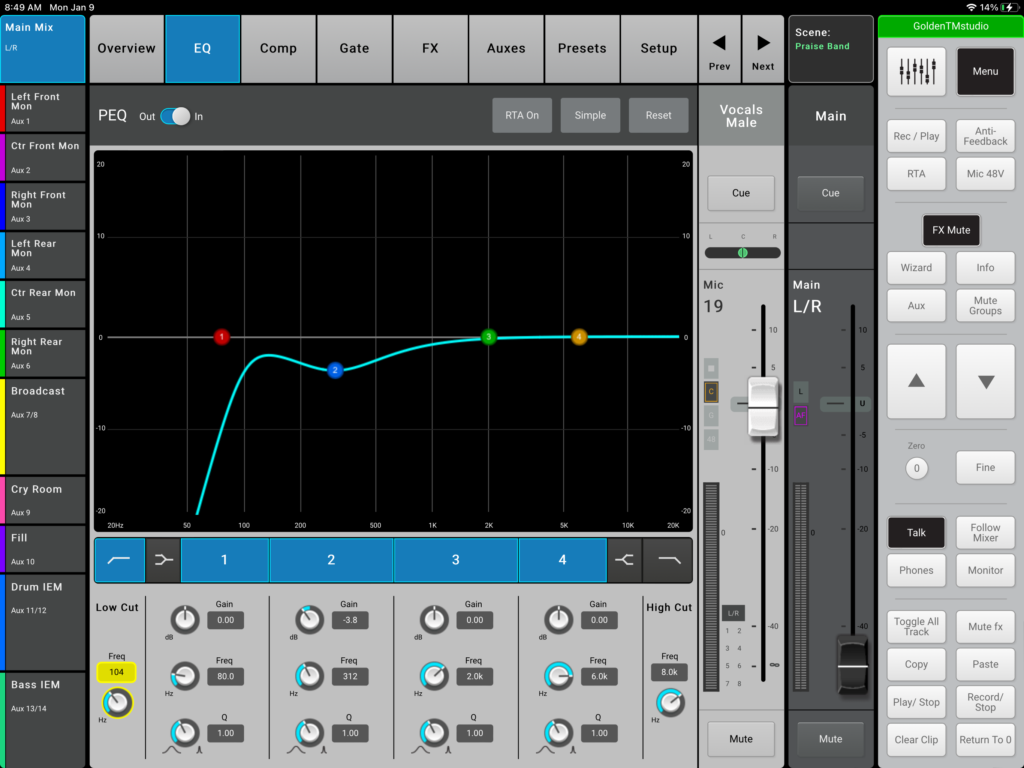Once upon a time, churches had no sound systems. The congregation sang their lyrics and sight read their vocal parts from hymnals. Fast forward to today; most churches are using current technology including sound systems, lighting, presentation software, cameras for live streaming and more. Unlike church from ages past, we must consider how to integrate today’s technology into our worship services. Developing a contemporary worship vocal team is no exception.
There are three elements that will positively impact the overall vocal sound of a worship team if we pay attention to them: Vocal Rehearsal, Vocal Mic Technique, Vocal Mix Technique.
Vocal Rehearsal
Most churches are utilizing untrained volunteers from their congregation as part of their vocal teams. Even the most talented vocalists will need guidance from the worship leader on how to use their gift within the context of their worship team. Vocals are what the audience follows to participate in the worship experience. This is why they need to be solid and why vocal rehearsals are so important.
However, rehearsing in person is a not always an option in today’s world. So, instead, you might consider using tracks for your vocalists to rehearse with on their own time. This can be as simple as singing a vocal part into a smart device. If you have experience, create tracks in a DAW (digital audio workstation). Mix band stems to the left and the vocal part to be learned to the right so that the vocalist can use panning to adjust how much of their part they want to hear. If you have neither the time or experience, consider buying band and vocal stems from reputable online resources like WorshipOnline.com.
Rehearsing vocals in this fashion is time intensive to set up. But once they are created you can store them online to be accessed by your worship team for all future use which will streamline your vocal rehearsals.
Vocal Mic Technique

Microphone technique has a very significant bearing on the quality of sound being delivered to the mix engineer. Before a vocalist joins the worship team, they should be trained on best practices when using their microphone.
1. Teach them why one must hold their mic in close proximity to the sound source, the mouth, as this reduces ambient noise bleed from the stage and monitors. A vocal mic that is held close to the mouth captures a wider range of frequencies from the vocal resulting in a fuller sound. Depending on whether the vocalist is singing lead or background vocals, one to four inches (2.5 to 10 cm) is what I would recommend.
2. Teach them how to sing into the mic and not off to the side. Most vocal mics on contemporary worship stages have cardioid pick-up patterns; meaning they will capture sound from the front and reject sound from the sides and back. Demonstrate what happens to the sound when one moves off axis of the pick-up pattern.
3. Teach them why one must not cup the ball of a directional dynamic mic with their hand. When a microphone of the cardioid family (including subcardioid, hypercardioid or supercardioid) is “cupped,” its unidirectional polar pattern tends to become omnidirectional, which, aside from changes in the frequency response, means reduced gain before feedback.
4. Teach them why you don’t point the microphone towards the floor monitors as this results in ear splitting feedback. This includes dropping your hand down by your side while holding a mic. There’s nothing like a live demonstration to teach this concept. For the person who struggles to remember these rules, consider having them use a mic stand.
Vocal Mix Technique
The mix engineer is just as much part of the worship team as any of the singers and musicians. When it comes to creating the contemporary vocal sound, the mix engineer is the final element in the chain. Fortunately, when elements 1 and 2, vocal rehearsals and vocal mic technique, are properly executed, the mix engineer will more easily be able to shape the vocal sound.
There is so much I could teach on this subject. We’ll save all the finer details of mixing vocals for another article. For now, let’s take a general look at 3 tools on your mixing console that will have the most significant impact on the vocal sound.
1. The first control to be aware of is the input gain. This can also be referred to as trim, preamp or head amp depending on the manufacturer of your console. This control is extremely important to set properly as it affects every channel parameter after this point. Have your vocalist sing into their microphone and turn up the input gain until the channel meter is hitting consistently around unity. Once your input gain is set you will not touch this control again unless the signal is clipping in which case you will back off on the gain until the signal is no longer clipping. After this is set, you will use the channel fader to make level adjustments.
2. One of the most common complaints I hear is that worship team vocals sound muddy and lack clarity. The easiest way to clean up muddy vocals is by implementing our best friend, the High Pass Filter (HPF). Some consoles may refer to this as Low Cut.
High pass filters remove low-frequency content that is not within an instrument’s or vocal’s frequency range. Eliminating unnecessary low frequency content from your vocal channels will add intelligibility allowing the vocals to cut through the overall main mix and monitors often without having to add any extra volume. As a general starting point, I place a high pass filter on each vocal channel at 100 Hz and make adjustments from there by soloing the vocal in my headphones, raising the HPF just before the point it starts to affect the fullness of that vocal.
You may find that some vocals need their HPF set higher than others. For example, a singer who tends to have their lips right on the mic. This introduces the proximity effect; a phenomenon that leads to an increase in low frequency response as you move the mic closer to the source.

3. Another very useful tool in your mixing console is your channel’s compressor. A compressor will reduce a signal’s dynamic range. Dynamic range is the difference between the loudest and quietest parts of an audio signal. In this extreme example, imagine a singer singing very softly and all the sudden belting it out on their mic. It ends up being distracting for the listener in the audience as they might struggle to hear the super soft part and then all the sudden blown out of their seats with the belting or loud parts. Using your compressor fixes this by attenuating (or making less) the loudest parts of your signal and boosting the quieter parts.
In the vocal application compression will help you to achieve a balanced, smooth, and blended vocal mix. Here is a good starting point for taming vocal dynamics and achieving consistent volume across all your vocal channels: Ratio 3:1, Attack Time 5 ms, Release Time 20 ms, Threshold -24 dB Gain. As always, you will use your ears to make additional adjustments.
Team Effort
As you’ve read this article you may have observed that producing the best contemporary vocal sound possible is a team effort between the worship leader, the worship team members, and the mix engineer. When each person does their part to contribute the team, the result is an engaging harmonious worship experience.
As published on WorshipFacility.com on December 1, 2022

Great article!